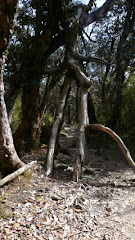A little star was born on 25 Feb 2010, slightly over 4 months from the time its egg was laid on 22 Oct 2009 in the land of Singapore, by a mother star tortoise in a tiny green garden in the west part of this tiny country.
It was a long and patient wait, incubating this little star in an artificial incubator carefully watched over by 2 adoptive parents, one of whom has the hobby of incubating all kinds of eggs and seeing them hatched. This little star was the first out of a batch of 7 eggs laid.
Have a look at its little beak and flippers trying to get out of the egg shell. It took 2 whole days to get to this stage.
Leisurely stretch of its head out of shell
In total, 7 days would be needed for it to completely get out of its shell, a painstaking process to the on-looker. The baby flapped its flippers and stretched out its head now and then, took lots of rest in between, and its frequent inactivity sometimes seemed that it has forgotten that it has been born. The baby is in no hurry, and neither should we humans, to get it out of its shell.
Then it began its first taste of food, and it was ferociously hungry!
Yum-yum, enjoying my first taste of a juicy cherry tomato!
Pardon my slurping. It is just too delicious.
For the laying of the eggs, please read my next post on Egg Laying.













